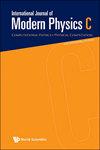时间尺度上淬火失序的Griffiths相
IF 1.6
4区 物理与天体物理
Q3 COMPUTER SCIENCE, INTERDISCIPLINARY APPLICATIONS
引用次数: 0
摘要
在接触过程中,由于各种原因,种群的恢复率可能不均匀。引入了两个不同恢复时间的agent共存的接触过程模型。只有当任何邻居独立于自己的状态被感染时,A类站点才有概率被感染[公式:见文本]。类型[公式:见文]站点,一旦被感染在[公式:见文]时间步后恢复,在[公式:见文]时间步后变得易感。如果易感,则键入[公式:见文本]站点被感染的概率[公式:见文本],如果任何邻居被感染。该模型在[公式:见文]处显示了从波动相到吸收相的连续相变。该模型属于小尺度定向渗流普适性类[公式:见文]。对于[公式:见文]的较大值,该模型属于激活标度通用性类。在这种情况下,在吸收阶段,两种类型的感染位点的比例在感染概率范围内呈现幂律衰减[公式:见文本]。一般幂律的这一区域被称为格里菲斯相位。对于[公式:见文本],受感染部位的比例达到饱和。对于任何一种类型的代理,局部持久性[公式:见文本]也显示出幂律衰减与连续变化的指数。因此,时间尺度上的淬灭无序可以导致模型中的时间Griffiths相位,显示向吸收状态的过渡。本文章由计算机程序翻译,如有差异,请以英文原文为准。
Griffiths Phase for Quenched Disorder in Timescales
In contact processes, the population can have heterogeneous recovery rates for various reasons. We introduce a model of the contact process with two coexisting agents with different recovery times. Type A sites are infected with probability [Formula: see text], only if any neighbor is infected independent of their own state. The type [Formula: see text] sites, once infected recover after [Formula: see text] time-steps and become susceptible at [Formula: see text] time-step. If susceptible, type [Formula: see text] sites are infected with probability [Formula: see text], if any neighbor is infected. The model shows a continuous phase transition from the fluctuating phase to the absorbing phase at [Formula: see text]. The model belongs to the directed percolation universality class for small [Formula: see text]. For larger values of [Formula: see text], the model belongs to the activated scaling universality class. In this case, the fraction of infected sites of either type shows a power-law decay over a range of infection probability [Formula: see text] in the absorbing phase. This region of generic power laws is known as the Griffiths phase. For [Formula: see text], the fraction of infected sites saturates. The local persistence [Formula: see text] also shows a power-law decay with continuously changing exponent for either type of agent. Thus, the quenched disorder in timescales can lead to the temporal Griffiths phase in models that show a transition to an absorbing state.
求助全文
通过发布文献求助,成功后即可免费获取论文全文。
去求助
来源期刊

International Journal of Modern Physics C
物理-计算机:跨学科应用
CiteScore
3.00
自引率
15.80%
发文量
158
审稿时长
4 months
期刊介绍:
International Journal of Modern Physics C (IJMPC) is a journal dedicated to Computational Physics and aims at publishing both review and research articles on the use of computers to advance knowledge in physical sciences and the use of physical analogies in computation. Topics covered include: algorithms; computational biophysics; computational fluid dynamics; statistical physics; complex systems; computer and information science; condensed matter physics, materials science; socio- and econophysics; data analysis and computation in experimental physics; environmental physics; traffic modelling; physical computation including neural nets, cellular automata and genetic algorithms.
 求助内容:
求助内容: 应助结果提醒方式:
应助结果提醒方式:


